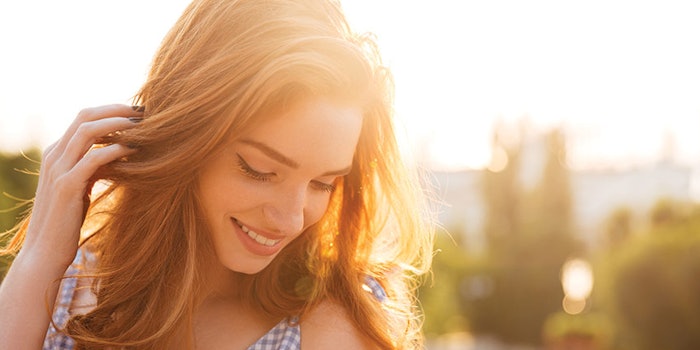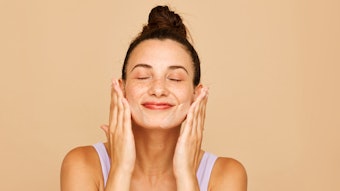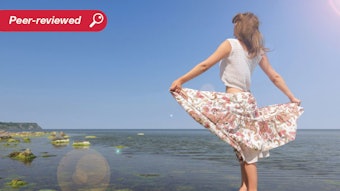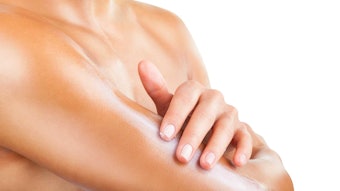
Most consumers are aware that exposure to UVB and UVA radiation accelerates skin aging and increases the risk of skin cancers such as melanoma. Therefore, agents for protecting the skin against UV radiation are not rare guests in consumers’ cosmetic bags; however, fewer individuals have awareness or concern that their hair is also affected by UV radiation.
Scientific and popular literature associate UV hair damage with dryness, increased breakage and split ends, lower luster and increased surface roughness 1—and all of these changes do not appear immediately or all at once in the same place. UVB radiation affects hair approximately 5 µm beneath the surface layer.2 For healthy hair, this is mainly the cuticle layers. For hair that has already been significantly damaged, i.e., due to intense bleaching and heat treatments, cuticles may already be missing. In this case, the cortex would be affected by UVB as well. UVA radiation is less intense but is capable of deeper penetration, thus the entire cortex may be affected.
Different hair properties can change at different rates. As such, in order to test preventative hair care treatments, sensitive techniques are required to detect low levels of damage that have not yet been translated into measurable changes in the mechanical properties of hair.
Laboratories often use accelerated weatherometers to simulate UV radiation, and the literature provides a wide variety of simulated exposure regiments. These are sometimes extrapolated into natural exposure times without references or data that could back up the extrapolation. Therefore, it is difficult to compare the results from different laboratories, or to decide which regimen to use for experiments.
Furthermore, the amount of UV radiation depends on one’s geographical region and the time of year. Consequently, weatherometer manufacturers typically do not provide a ratio for the number of exposure hours of natural and simulated UV radiation. However, spectral curves are provided, and these show that the spectrum of UV light closely resembles that of solar UV radiation (see Figure 1).
In the present work, the authors investigated the possibility of using differential scanning calorimetry (DSC) to define a ratio between artificial and natural irradiance levels. From this data, methods were developed as described in order to substantiate desired claims for UV protection in hair.
DSC for Artificial/Natural Light Exposure Ratio
Virgin, unpigmented hair (known as Piedmont) was used as the test substrate to evaluate the levels of protein damage induced by either natural or artificial UV sources. The hair was exposed to either a combined total of 45 hr of natural daytime weathering in Nevada, U.S., or was irradiated using a weatherometera (0.67 W/m2) for up to 100 hr. DSC was then used to investigate the samples.
DSC can provide information about two parameters: denaturation temperature (Td) and enthalpy.
Denaturation temperature data allows for the evaluation of cross-link density changes in the hair matrix, which is composed of amorphous proteins. Denaturation enthalpy reflects the condition of the structured hair protein.3 Since the denaturation temperature is more sensitive to UV-inflicted protein changes in hair, this parameter was used for further evaluation of protein thermal stability.
Results indicated 45 hours of natural weathering reduced the denaturation temperature of hair to levels similar to 10 hours of artificial weathering.
DSC curves were obtained by testing the ~10 mg exposed hair samples. The samples were placed in high-pressure DSC pans, together with 50 μL of water. The typical heating rate used for claims substantiation purposes was 10°C/min.
Results: Superimposed denaturation temperature data of the differently weathered hair is presented in Figure 2. The results show that 45 hr of natural weathering reduced the denaturation temperature of hair to similar levels as that of 10 hr of artificial weathering. Consequently, for testing purposes, the ratio of 1:4.5 between artificial and natural exposure times was adopted, to give similar damage level results.
UV Resistance of Hair
Besides these differences in exposure, it was important to understand how different types of hair resist UV radiation and damage. The denaturation temperature results of unpigmented and medium brown virgin hair, as well as bleached hair, are presented in Figure 3 and Table 1. Here, it is clear the denaturation temperatures were higher in undamaged hair and hair with higher melanin content. Thus, more pigmented hair decayed at a slower pace. Since the initial thermostability of the tested hair differed, Td changes (DTd) were used for further analyses rather than absolute Td values.
In analyzing Table 1, where DTd after 10, 20, 50 and 100 hr of UV radiation are presented, it is notable that the difference between the decrease in denaturation temperatures of pigmented and unpigmented virgin hair after 100 hr is rather small (~1.7°C). Indeed, virgin hair appears to be able to handle exaggerated UV radiation relatively well: 20 hr of simulated weathering, which is equivalent to ~90 hr of sun exposure, decreased the Td by slightly less than 4°C. An additional 30 hr in the weatherometer was required to double this decrease.
Discussion: Many hours of exaggerated weathering were necessary to achieve sufficient levels of damage, which conflicts with two practical aspects of claims substantiation: reasonable reapplication time and good testing resolution. A rational reapplication time would allow a sufficient amount of UV radiation-absorbing active to last throughout the entire UV exposure time. To achieve good differentiation using virgin hair, however, 50-100 hr of UV exposure time would be required. This not only increases testing costs, due to the several reapplication times required to correspond with 225-450 hr of natural UV exposure, but it is not realistic.
In bleached hair, however, the hair matrix was very sensitive to UV; the sharpest decrease in denaturation temperature of this substrate was recorded during the first 10 hr, reaching an average DTd = 13.9°C. Further, the thermal stability of the protein decreased more slowly with increasing duration of simulated weathering. This finding gave good resolution for claims substantiation and saved the testing costs of product reapplication.
Protection Claims for Hair
Armed with the DSC data on natural versus artificial UV exposure, plus hair type versus its endurance for UV exposure, the researchers could move forward with the development of test protocols to substantiate UV protection claims for hair care.
Continue reading in our April 2019 Digital Edition...
References
- Signori, V. (2004). Review of the current understanding of the effect of ultraviolet and visible radiation on hair structure and options for photoprotection. Intl J Cos Sci, 26(4), 219-219.
- Lee, W. S. (2009). Photoaggravation of hair aging. Intl J Trichol, 1(2), 94.
- Istrate, D., Popescu, C., and Möller, M. (2009). Non-isothermal kinetics of hard a-keratin thermal denaturation. Macromolecular Biosci, 9(8), 805-812.
- Evans, T.A. (2015). Quantifying hair color fading. Cosm & Toil, 130(1), 30-35.
- Evans, T.A. (2011). Evaluating hair conditioning with instrumental combing. Cosm & Toil, 126, 8.












